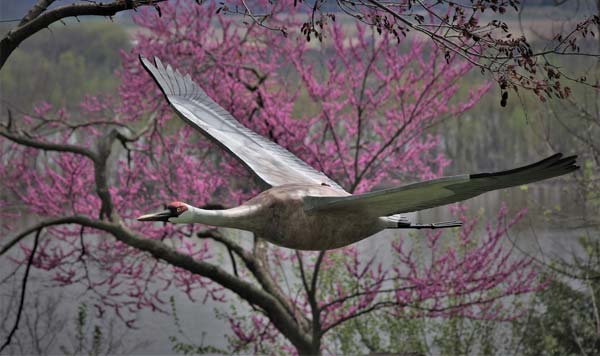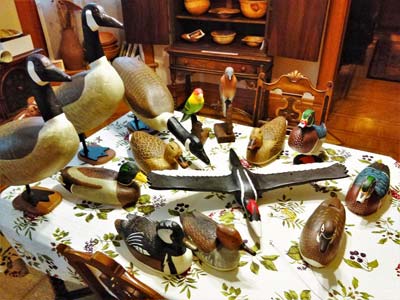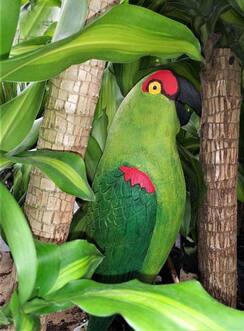Dean Hurliman -- Poet and Woodcarver
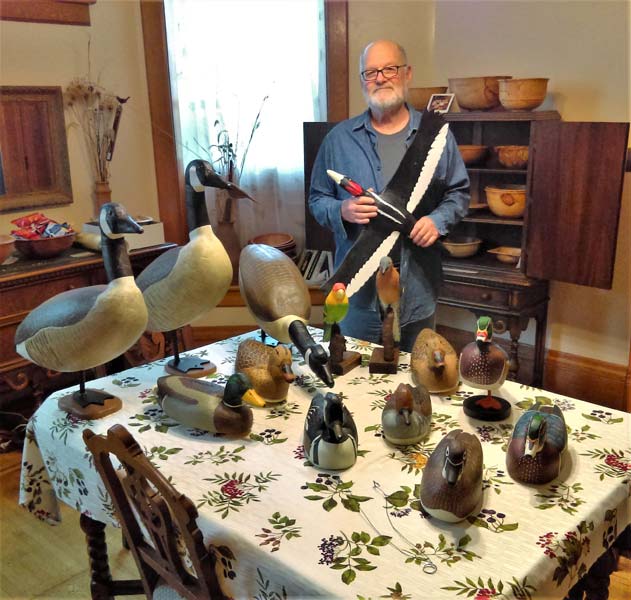
Noted Bird carver and LLA 2019 Elder Intern, Dean Hurliman has donated a collection of over 20 of his carvings to the Leopold House for use in the children's library. It will be so valuable having these life sized 3 dimensional sculptures to engage children in the diversity of the natural world. We hope to grow more birders in the Leopold Neighborhood!
We are especially excited to use some carvings of extinct species as an exhibit to help children see the fragility of our natural systems. Dean has a similar display of lost species at the Univ. of SC at the McKissick Museum.
Prospect Hill School, Aldo & Dean's grade school, produced some gifted students !
A Life Outdoors
Starting with a white pine board given to him by his wife, Karen, in the early 1970's, Dean went on to create more than 300 decoys. Musical inspiration was provided by earliest recordings of Cajun, Delta Blues, Stephen Foster, and moderns such as Enya and McKennitt. Snippets of gospel hymns first graced the bottoms of some birds, later Dean's original poems. None of the birds are for sale, but are given away as seen fit. A sincere emotions response is payment enough. Recently Dean has found a new vitality in carving endangered species. With the sighting of the Ivory-Billed Woodpecker in the South, Dean became interested in carving threatened species to help their human relatives become more sensitive to endangered animals.
Extinct and Threatened Species
Some of Dean’s waterfowl carvings were of species that were once endangered and brought back to stability by conservation efforts, like the wood duck, hooded merganser, whistling swan (trumpeter) and even the Canada goose. Others, like the black duck and canvasback, continue to decline or fluctuate greatly in numbers.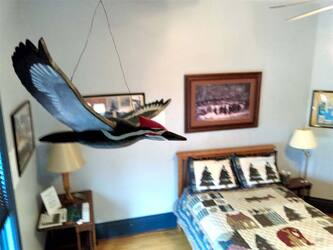
When ivory-billed woodpeckers were spotted for the first time in decades, Dean became interested in this hopeful event and shifted his focus to the plight of endangered birds.
Carving ivory-billed woodpeckers (possibly now extinct) led to carving other extinct species like the passenger pigeon and the Carolina parakeet. It’s amazing how holding a wooden bird helps people understand the tragic loss of these iconic American birds.
Bringing attention to endangered or threatened species helps tell the hopeful story of recovery, and celebrates some birds almost lost due to human development.
With the ongoing search for the ivory-bills (Lord God Bird), Dean realized it might also be helpful to carve flying examples of the similarly colored, but smaller pileated woodpecker—same colors, but differently marked. [Many flying ivory-bills have been donated to exhibits in wildlife refuges and museums. Now 50 pileated sculptures are exhibited around the country.]
With his new focus on the fragility of birds, Dean realized that many other species are threatened due to habitat loss and fragmentation of their needed vegetation zones.
The idea of focusing on extinct and threatened species has taken hold of Dean’s wildlife interests. His most recent carving challenge is the thick-billed parrot, a bird admired by Aldo Leopold. During Aldo’s trips to the Rio Gavilan in New Mexico, he described the flying, raucus flocks and revered the “motive power” they gave the landscape.
Just a few years after Aldo’s surprise with the parrots (called Gucamaya in Mexico), the bird was in serious trouble due to increasing fragmentation of habitat. So now the first perched and flying thick bills are being carved for LLA to display in Aldo’s childhood home on Clay Street.
Leopold wrote of so many iconic birds. He got his start in conservation as a birder in childhood, and described many favorites. Who knows, maybe our friend, the bird Carver Poet of Burlington, will write about more of his favorites.
Dean’s birds and poems are helpful in education programs, especially for children who may not yet have had the chance of a sudden encounter with birds in the wild. Just maybe being surprised by the life size birds at the Leopold Compound will excite a child, and nudge him or her into a search to find their own favorite species.
In 2022 Dean created a life sized, flying sandhill crane! Although in the picture below he is flying through the Starker-Leopold yard, he now flies around the future Children's Center in the barn loft. Thanks, Dean!
